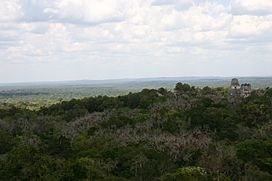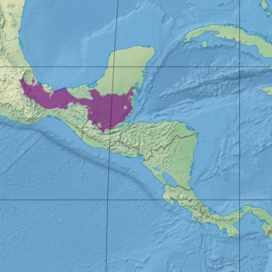Petén–Veracruz moist forests facts for kids
Quick facts for kids Petén–Veracruz moist forests |
|
|---|---|

|
|

Ecoregion territory (in purple)
|
|
| Ecology | |
| Realm | Neotropical |
| Biome | tropical and subtropical moist broadleaf forests |
| Borders |
List
|
| Bird species | 468 |
| Mammal species | 191 |
| Geography | |
| Area | 149,100 km2 (57,600 sq mi) |
| Countries | Mexico, Belize, and Guatemala |
| Conservation | |
| Conservation status | critical/endangered |
| Habitat loss | 23.595% |
| Protected | 24.25% |
Imagine a huge, green forest stretching across parts of Mexico, Guatemala, and Belize! This amazing place is called the Petén–Veracruz moist forests. It's a type of ecoregion (a large area with similar plants and animals) known for its warm, wet weather and many broadleaf trees. Think of it as a giant, lively jungle!
Contents
Where in the World Are These Forests?
These moist forests cover a huge area, about 149,100 square kilometers (that's about 57,568 square miles!). They stretch from central Veracruz in Mexico. From there, they go across parts of Oaxaca, Tabasco, Chiapas, and Campeche states in Mexico.
The forests also cover northern Guatemala and most of Belize. Two famous parts of this ecoregion are the Lacandon Forest in Chiapas and the Petén Basin in Guatemala.
Rivers and Lowlands
The Petén–Veracruz moist forests are mostly found in low-lying areas near the coast. Many winding rivers flow through this region. Some of the important rivers include the Blanco, Papaloapan, Coatzacoalcos, and Usumacinta. These rivers help keep the forests moist and full of life.
Neighboring Natural Areas
This ecoregion has many different neighbors. To the south, it meets tall mountain ranges and highlands. These include the Sierra Madre de Oaxaca and the Guatemalan Highlands. In these higher places, the moist forests change into mountain forests or pine-oak forests.
Near the Gulf of Mexico, you'll find the Petén–Veracruz moist forests. However, some areas like the Sierra de los Tuxtlas mountains and the Pantanos de Centla wetlands are different types of ecoregions.
To the east, the forests reach the Caribbean Sea in Belize. Here, you might find small areas of Belizian pine forests within the larger moist forest. Along the Caribbean coast, there are also Belizean Coast mangroves, which are special forests that grow in salty water.
Who Lived Here? Ancient and Modern People
These forests have been home to people for a very long time.
Ancient Civilizations
The northern part of the Petén–Veracruz moist forests was home to the ancient Olmec culture. They built amazing cities between 1200 and 400 BCE (that's before the Common Era!).
Later, the Classic Maya civilization (from 250 to 900 CE) was centered in the eastern and southern parts of this ecoregion. This area is sometimes called the Selva Maya. It stretched from Tabasco and northern Chiapas in Mexico, across northern Guatemala, and into Belize. The Maya built incredible cities and temples in these forests.
People Living Here Today
Today, many different groups of people live in these forests. Modern Mayan people still live in the eastern part of the ecoregion. In the western part, you'll find Mixe–Zoque and Nahuatl peoples. These communities often have deep connections to the land and its resources.
Protecting These Important Forests
It's super important to protect these moist forests because they are home to so much wildlife and unique plants. About 22% of this ecoregion is now part of protected areas.
Special Protected Areas
These protected areas help keep the forests safe from harm. Some of the most important ones include:
- The Maya Biosphere Reserve in Guatemala.
- The Montes Azules Biosphere Reserve in Mexico.
Other protected places are national parks like Tikal and Palenque. There are also biosphere reserves like Calakmul. These areas are like giant nature parks where plants and animals can thrive without too much human disturbance.
See also
 In Spanish: Bosques húmedos de Petén-Veracruz para niños
In Spanish: Bosques húmedos de Petén-Veracruz para niños
- List of ecoregions in Guatemala
- List of ecoregions in Mexico

